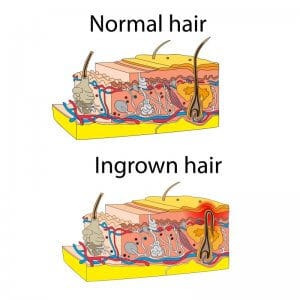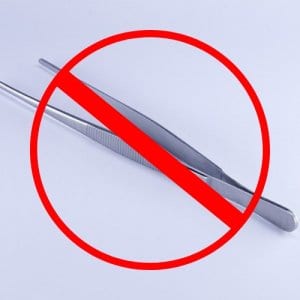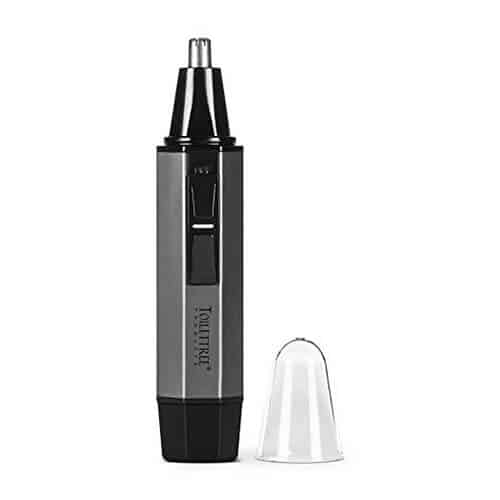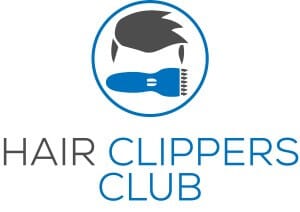But, it seems an ingrown nose hair is much worse. They hurt a lot, are unsightly and can even be dangerous.
Are looking for some ways to get rid of them and prevent yourself from getting them again?
Well, you came to the right place. As a barber I have been giving advice on how to get rid of ingrown hairs for years so now I am here to help you if you have infected nose hair follicles too!
You definitely don’t want to wait long to take care of ingrown nose hairs as they can potentially be dangerous. One thing razor bumps are not is dangerous, but when dealing with infections on or around the nose you have to be careful.
Read on to find out what home remedies I recommend and what to do if they don’t work.
What is an ingrown hair?

Ingrown hairs are extremely common as they are simply hairs that have curled back inwards as they grow which causes them to grow underneath the skin.
Usually they are caused when you shave an area, particularly where the hair is very curly like your beard or pubic hairs. Though, they can grow anywhere there is a hair follicle, namely nose hair.
Since the hair can attract bacteria, it can become infected which is then something called folliculitis. Folliculitis can happen just by the hair follicles getting infected, even if there is no ingrown hair present.
What is the difference? Well, they both kind of look the same, but folliculitis can pretty much happen anywhere and usually it spreads to other follicles end up getting infected too. If you see many small red pimples then this is likely folliculitis. If you have more sparsely situated bumps that look like bigger pimples then this could be a set of ingrown hairs.
How do ingrown nose hairs happen?
I know how tempting it is to just pluck a nose hair out of your nose. You may have a long nose hair just dangling there and can even grab it with your fingers and yank it out. Don’t do this!
The biggest cause of ingrown hairs in your nose is from tweezing or pulling them out.
That’s not the only way but it is the most common. You can also get ingrown hairs by aggressively blowing your nose or from picking it.
The problem is that your nose hairs are wiry and the skin is a very thin and moist membrane that can easily attract bacteria.
A long nose hair that gets trapped under this skin and is then exposed to bacteria is a recipe for a very painful nasal passage.
That’s how it happens inside the nose.
You can also get ingrown nose hairs on the outside too. This happens because your nose tends to be greasy and this grease can trap grime in the pores. When your pores are clogged, the hair may have trouble breaking through and grow sideways.
Your best bet is to get yourself a good nose hair trimmer to not take any chances. Then just make sure you are keeping up with it so you don’t have any annoying long nose hairs.
How long do ingrown hairs last?
While there are a few treatments and home remedies for ingrown hairs some people prefer to just wait it out. But, how long does that take?
This isn’t easy to answer as it can range from a few days to never. This is assuming you choose to do nothing.
As the skin grows more layers, the hair will have even more trouble growing out so it may take a few weeks for the hair to be strong enough to poke through. In some cases it might not ever but the infection can go away on its own.
The best bet is not to wait it out and actually take measures into your own hands.
In the case of infect nose hair follicles, it can be dangerous to wait it out.
Think about it.
Your nasal cavity goes pretty much right into your brain. If you get an infection inside your nose then it can go directly into your brain.
This is why you also need to be very careful when trimming your nose hair.
Ingrown Nose Hair Remedies
Before you can set out to get rid of your ingrown hair, you have to figure out if that is indeed what it is and then try to figure out where it may actually be located.
If you are feeling some pain inside your nostril and when you press your nose closed and you feel some pain that doesn’t really tell you what and where it is.
Tip #1 Do Some Recon
Try to see if you can use a mirror to look inside and get an idea of what is going on in there. Or have somebody else that isn’t squeamish take a look.
What you are looking for is a pimple essentially. If there are several smaller pimples scattered about in there then you probably have folliculitis and not an ingrown hair. Though much of the procedures to get rid of ingrowns will apply to folliculitis too.
Tip #2 Use a Compress
Since your ingrown hair is infected if it is painful then using a hot compress will help draw out the bacteria.
It is a simple procedure and should be tried before you attempt anything that is more invasive and painful.
Use a cotton ball and a pair of tweezers and add dip it in some hot water. If the water is too hot to the touch it will be too hot to put in your nose so wait until it is manageable. It should still be hot but not so much it will burn your nasal membrane.
If it is on the outside of your nose then it can be hotter as the skin won’t be as sensitive.
Keep it gently pressed against the infected area until it cools down. Then repeat a couple more times.
You may see some puss or blood but don’t worry that is actually a good thing.
Try this several times per day for a couple of days and see if there is a reduction in pain and size. If not then proceed to the next tip.
Tip #3 Use a Needle and Tweezers
After trying the compress, you may see the actual hair that is causing the problems inside the pustule. If this is the case then try to remove it.
To do this you should use a cotton swab with a few drops of alcohol and moisten the infected area. This will help disinfect it.
Then dip a needle in the alcohol to disinfect that as well.
Using the tip of the needle, try to slide in underneath the hair and then gently lift it up. If you are successful and it was a long nose hair then you’ll see some of the follicle actually poking out of the pimple.
Now disinfect some tweezers by placing the tips in some alcohol and then gently pull the hair out.
Tip #4 Try Antibiotic Cream
At this point, you’ve removed the offending long nose hair but you still have an infected pimple.
You can go with a simple treatment of hydrogen peroxide dipped cotton swab and apply it to the area, or use an antibiotic cream like bacitracin from Amazon.com. I definitely recommend stocking up on some in case you have more cases later and it is generally a good idea to always have some on hand anyway.
Alternatively, tea tree oil is a great way to naturally disinfect an area and prevent recurrences.
Tip #5 Know When to See a Doctor
If the infection is not going away after you’ve tried these methods, then you may want to see a doctor. If it is painful enough to make it hard to perform your tasks during the day or is keeping you awake at night then that isn’t normal. You may now have an abscess that will only get bigger and more painful. You may need the doctor to drain it for you and prescribe some medication, probably oral.
If during any of this you feel a fever or nausea and generally unwell aside from any pain or discomfort then go right away to your doctor as you may have some complications from the infection.
How to prevent ingrown nose hairs

Now that you have removed the hair and disinfected the area, you need to use some prevention measures to avoid ingrown hairs from growing again.
If you have been tweezing your long nose hairs or pick your nose then stop doing that immediately.
Don’t even use any nose hair trimmers until you have gotten rid of the infection completely.
You can use some essential oils like tea tree oil or rosemary oil to keep the nasal passage clean for a few days after you’ve gotten rid of the infection. This will make sure there is no lingering bacteria in there.
If the ingrown hair was outside your nose then make sure you are exfoliating your skin well. If you have hairs growing on the end of your nose, then it is ok to pluck it out, but keep an eye on how the hairs grow back in.
As far as inside your nose goes, avoid picking your nose or generally putting dirty fingers up there. And always use a disinfectant on any nose hair trimmers you use before you trim.

Is waxing long nose hair safe?
You may be tempted to wax the nose hairs, but it is the same as pulling them out with tweezers. In other words, it is not a good idea.
If you have chronic ingrown nose hairs then this is one of the worst things you can do to get rid of nose hairs.
When you tweeze the hairs, at least you’re only doing potential damage to that confined area. Waxing can damage the nasal membrane all throughout your nostril. You’ll have increased the chance of infection by a huge degree and you open yourself up to ingrown hairs.
It is also very unnecessary since we need our nose hairs to help keep grime, pollutants, fungus and bacteria from getting into our system. You don’t need to grow crazy and get rid of all of your nose hairs, just trim the big ones that can be seen. Leaving the rest will help your nose stay clear of possible infections and your overall health much safer.
Final Thoughts
I know thinking about your nose hairs and adding another thing to be concerned about is not something you really want.
But if you have an ingrown nose hair now or have had them frequently in the past then it means you really need to be conscious about it. Follow these tips on getting rid of ingrown nose hairs and then make sure you do what you can to keep them from coming back.
It may seem alarmist to talk about the dangers of infections from something as simple as an ingrown hair, but it can be serious.
If you have any questions about trimming your nose hairs or other problems then make sure you drop a line in the comment box below and I will get back to you as soon as possible.
In the meantime, I want to reiterate that if you are in intense pain from an ingrown nose hair that you should see a doctor right away.
I’m an outdoor enthusiast and have sported a full beard since I was in my early 20’s. Originally, growing a beard was a way to save time when getting ready each day, but I quickly realized that keeping a neatly trimmed beard takes work and some forethought. That’s where this site comes in.
You get to benefit from my years of experience. I’ve reviewed many of the top hair clippers on the market today and also included some information on what works best for me. A great beard will turn lots of heads in your direction.
Since I never know when I’m going to find myself being photographed, whether it’s climbing in Yosemite, or playing volleyball on the beach, it’s important to me to always look my very best. Maintaining my beard is part of my daily routine and I hope you’ll find some useful tips and information on this site to help you on your journey.
